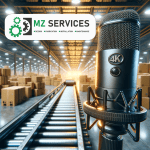
In the world of material handling, cleated belt conveyors stand out as a unique solution for specific challenges. In this blog, we’ll delve into what cleated belt conveyors are, their advantages, the various types of cleats available, and their diverse applications across industries. So, if you’ve been pondering about integrating this system into your operations, read on!
Introduction: What is a Cleated Belt Conveyor?
A cleated belt conveyor is distinct from traditional conveyors, boasting raised cleats on its surface. These cleats can be custom-designed based on the material they need to transport, ensuring that products remain in place during inclines or declines1. Especially useful for loose or bulky materials, cleated belts prevent items from sliding off, ensuring efficient and safe transportation.
Advantages of Cleated Belts
- Prevent Product Slippage: With cleats, the chances of products slipping or rolling are significantly reduced2.
- Flexibility: They can be designed to handle various products, be it light or heavy3.
- Efficiency: Cleated belts optimize the conveyor’s speed, ensuring faster transportation and increased throughput.
Types of Cleats
There are several cleat designs to choose from, depending on your needs:
- T-shaped cleats: Ideal for small to medium-sized products4.
- L-shaped cleats: Great for products that require more side support5.
- Curved cleats: Best for delicate items that need gentle handling6.
Applications and Industries
Cleated belt conveyors are versatile, finding applications in numerous industries:
- Food Industry: Transporting packaged items or raw materials without compromising hygiene7.
- Pharmaceuticals: Moving pills, bottles, and other delicate products8.
- Agriculture: Handling grains, seeds, or harvested crops9.
Installation Tips
When installing a cleated belt conveyor, consider the following:
- Space: Ensure you have enough space not just for the conveyor but for maintenance activities10.
- Load: Understand the maximum load the conveyor can handle to prevent breakdowns11.
- Safety: Make sure to install safety measures, such as emergency stops12.
Cleated belt conveyors offer a specialized solution for many material handling challenges. By understanding their advantages and applications, you can make an informed decision for your operations. Remember to always consult with a professional before making a purchase to ensure you get the right fit for your needs.
In the evolving world of industry, staying informed is crucial. We hope this blog shed some light on the benefits and applications of cleated belt conveyors. Happy conveying!
Sources:
[1] C&M Conveyor – Cleated Belt Conveyors
[2] ThomasNet – Advantages of Using Belt Conveyors
[3] Fluent Conveyors – Types of Conveyor Belts
[4] Belt Technologies – Different Types of Conveyor Belts
[5] Conveyor Belt System Advantages
[6] Kinder – Types of Conveyor Belt Cleats
[7] Food Manufacturing – Conveyors in the Food Industry
[8] Pharma Manufacturing – Conveyors in Pharma
[9] Agriculture.com – Conveyor Uses in Agriculture
[10] Cisco-Eagle – Conveyor Installation
[11] Conveyor System Load Carrying
[12] Conveyor Safety Measures
